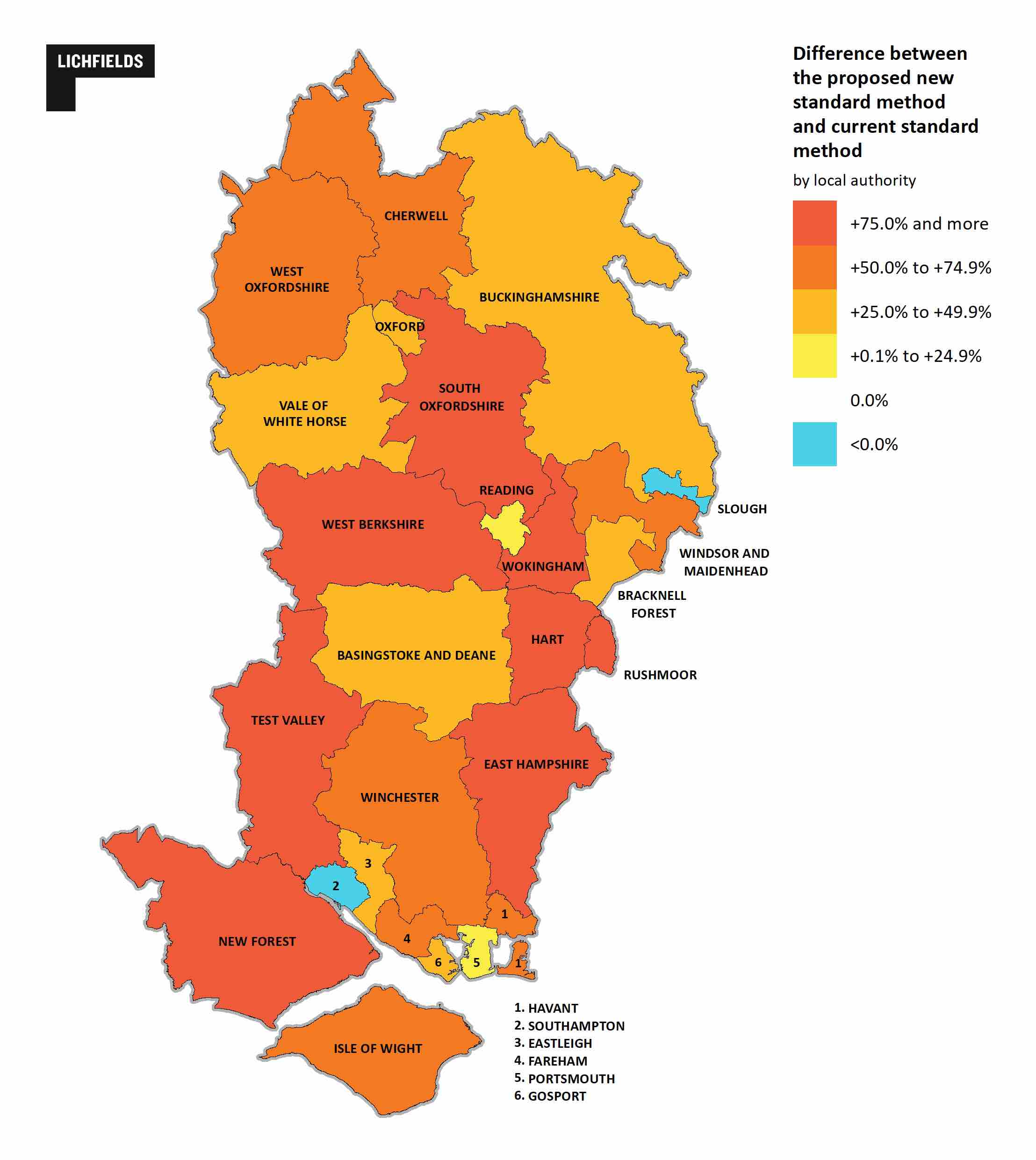As Reading Borough Council agrees to go out to consultation over its draft Local Plan, planners at Lichfields have run the rule over it in the context of the Labour Government’s planning policies. Lichfields planning director Nick Kirby and planner Florence Leung (pictured above) explain.
It’s one year since Lichfields’ post appraising Reading Borough Council’s (RBC) Local Plan Partial Update (draft LP November 2023) and the ‘big squeeze’ facing Reading to accommodate its increasing development needs within tight spatial constraints.
That blog questioned whether RBC could meet its needs without a fundamental change in its approach to permitting tall buildings, and the council’s recently published updated draft plan partially answers this.
Reading is still not (yet) a city, but it remains one of the top places to live in the UK and has been ranked the fifth best city for ‘good’ economic growth in the UK, within the 2024 Good Growth for Cities report. Reading is defined nationally within planning guidance as one of the 20 largest ‘urban centres’, meaning that it is subject to a 35 per cent uplift on its baseline housing need.
In the context of the borough’s continued growth, RBC has now published its draft Local Plan, the Pre-Submission Draft Partial Update (PS Plan), which outlines the proposed strategy and policies for development in RBC until 2041, and responds to previous consultation comments.
Changing planning context
The updated PS plan has been published against a political backdrop and planning context which has undergone substantial changes since consultation on the earlier draft LP November 2023.
As a new Labour Government (now politically aligned with the leadership of RBC) pursue a national housebuilding target of 1.5 million new homes over this Parliament, the role planning has to play in achieving this is receiving significant attention. A series of reforms to the planning system were consulted on shortly after the election, including revisions to the National Planning Policy Framework and an update to the Standard Method for calculating local housing need.
The Standard Method was first introduced in 2017 but gained notoriety in 2022 when proposals to change it in 2020 gained significant media attention and earned the pejorative ‘the mutant algorithm’. The latest update to the Standard Method proposed in 2024 would substantially increase the baseline housing need for the vast majority of local authorities in the Thames Valley– including Reading as shown below.

Additionally the draft NPPF proposed various transitional arrangements. These effectively mean that councils with emerging Local Plans which have reached pre-submission stage (as RBC’s now has) can progress Local Plans on the basis of the current lower Standard Method housing need, so long as the Local Plan’s housing requirement is not more than 200 dwellings below the higher housing need figure resulting from the draft Standard Method.
Housing need in Reading
Table 1 puts this into context, showing that the proposed housing provision figure underpinning the emerging PS Plan (item e) represents an increase on the housing need planned for within the existing adopted Local Plan (item a). Despite RBC carrying out their own housing need assessment which identifies a local housing need of 735 dwellings per year (item d), the PS plan recognises the need to exceed this figure, in order to ‘continue to address the housing crisis and to reflect national policy’. Therefore the pre-submission plan 2024 proposes a target of 825 dwellings per year (item e), which reflects RBC’s assessment of the borough’s housing residential capacity for the plan period to 2041.
Despite RBC carrying out their own housing need assessment which identifies a local housing need of 735 dwellings per year (item d), the PS plan recognises the need to exceed this figure, in order to ‘continue to address the housing crisis and to reflect national policy’. Therefore the pre-submission plan 2024 proposes a target of 825 dwellings per year (item e), which reflects RBC’s assessment of the borough’s housing residential capacity for the plan period to 2041.
However, this still lags behind the housing need figure calculated by the existing Standard Method (item b), and significantly behind the need figure generated by the draft standard methodology (item f) consulted on by the new Labour Government. Such is the Government’s drive for housing, RBC will have to provide ‘exceptional circumstances’ for why the new Local Plan falls short of the higher Standard Method housing need (b) even if it progresses in advance of the NPPF being amended.
With the new Labour Government’s clear focus on housing delivery and the key role urban areas such as Reading have to play, how does RBC’s PS Plan seek to accommodate increasing housing needs, and does it go far enough given the shortfall identified against national requirements?
Where to live
Within the PS plan, Central Reading remains the primary focus for housing with 59 per cent of the homes proposed in central area across the plan period (approximately 8,700). However, a fundamental change to this approach in the PS Plan (and perhaps the skyline of Reading) is the widening of spatial areas in which ‘tall buildings’ (defined as 10 storeys of commercial floorspace or 12 storeys of residential or above) may be acceptable.
The adopted Local Plan restricts the construction of tall buildings to three specific clusters around Reading Station, west of St Mary’s Butts and along King’s Road in the eastern part of the town centre. This approach has been largely complied with since the Local Plan’s adoption with no tall buildings being permitted outside of designated clusters.
The PS plan proposes to introduce ‘areas of less suitability for tall buildings’ which despite this curiously negative phrasing, widen the areas where tall buildings can be considered acceptable, subject to assessment of detailed effects. The majority of these new areas of greater flexibility represent extensions to the existing tall building clusters, but The Oracle and surrounding area falls within an entirely new proposed designation.
Alongside this apparent flexibility for tall buildings, the PS Plan proposes a minimum density for residential development in the town centre of 260 dwellings per hectare (dph) subject to detailed considerations.
Whilst 260 dph represents an increase from the proposed figure in the draft LP November 2023 (200 dph), it is considerably lower than the average density achieved in the town centre (334dph) over the past decade of 2013-2023 as noted by RBC in the draft LP November 2023.
Additionally, 31 new site allocations are also proposed within the PS Plan to provide new homes, half of them within Central Reading. The PS Plan also recognises the needs for emerging housing types with policy on ‘purpose-built shared living accommodation’ (also known as co-living), which has seen a growing market in major cities across the UK in recent years.
Alongside new housing provision, the PS Plan proposes new policies reinforcing sustainability requirements including:
Restricting demolition of existing buildings unless fully justified, including diverting construction waste away from landfill to minimise environmental footprint
Introducing an Urban Greening Factor Assessment requiring proposals to demonstrate how varying levels of green cover will be delivered on site, dependant on the scale of the proposals.
What’s next?
The PS Plan will be consulted on during November and December 2024, during which time it will be possible to make representations on all aspects of the plan, from the level of housing provision proposed to the detailed policies affecting development.
After this consultation stage, RBC will review the consultation comments and if they consider that no major changes to the plan are required, it will be submitted to the Secretary of State, anticipated to be in February 2025. The examination process which follows (expected to be May/June 2025) will involve a number of public hearings, to assist the Government inspector’s assessment of whether the plan is ‘sound’ and legally compliant.
The PS Plan is an interesting test case for how far a Labour-led council can and should contribute to the now Labour Government’s pro-growth agenda. Currently the plan’s shortfall in proposed housing against both the existing Standard Method and draft Standard Method proposed by the new Labour Government is representative of the challenge of Government to reach the 1.5 million homes across this Parliament even within councils of the same political persuasion.
© Thames Tap (powered by ukpropertyforums.com).
Sign up to receive our weekly free journal, The Forum here.










Ridiculous situation. Reading should be able to boast as many high rise buildings as is needed. For too long the council has been negative about allowing buildings getting near the 100m mark.
It’s about time they just allowed buildings to be as tall as needed, Reading is big enough to accommodate such buildings.